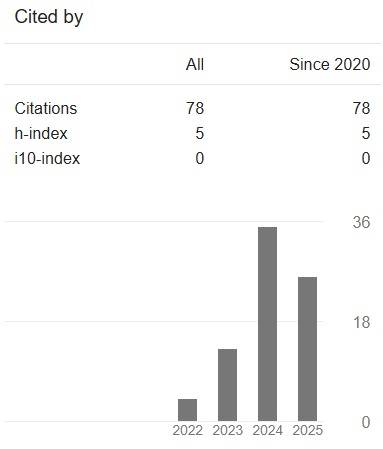CFD analysis of thermal comfort in hospital operation room with different air distribution design and operative temperature
DOI:
https://doi.org/10.24191/jaeds.v1i1.23Abstract
The operation room is one of the most critical regions in hospital that require extra attention in air ventilation and prevention of dangerous pollutants contamination. A good level of ventilation will help to raise the productivity of workers in terms of performance and ensuring a safe surgery operation. It is obvious that today's operation rooms are completely equipped with mechanical ventilation systems. However, despite the fact that they meet the acceptable comfort standards, surgical workers have complained about thermal discomfort during operation which gives negative impact on their performance. Thermal comfort can be achieved by controlling the temperature, relative humidity and air movement. In this study, the operation room models are simulated to analyze the comfort conditions of surgical workers under 3 different air velocities at 0.2 ms-1, 0.25 ms-1 and 0.35 ms-1 and under 5 different temperatures between 16℃ to 20℃. Additionally, there are two 3D models created with different position of exhaust vent. The thermal comfort of surgical workers is measured using Predicted Mean Vote (PMV) and Predicted Percentage Dissatisfied (PPD) approaches using CBE Thermal Comfort Tool. The PMV and PPD results show that most surgical workers were outside the acceptable range value of -0.5 to +0.5 stated in ASHRAE Standard 55-2020. According to thermal scale index, most of the surgical workers were in a cool and slightly cool state despite the fact that the computational analysis shown an acceptable simulation validated with previous research studies. Finally, it has been discovered that clothing insulation, metabolic rate, mechanical equipment and air distribution design play a significant influence in providing comfort to the surgical workers.
Downloads
References
Ding Lai Chet, “Case Study of Air Distribution of the Hospital Operating Room in Malaysia,” 2012.
I. Nastase, C. Croitoru, A. Vartires, and L. Tataranu, “Indoor Environmental Quality in Operating Rooms: An European Standards Review with Regard to Romanian Guidelines,” Energy Procedia, vol. 85, pp. 375–382, 2016, doi: 10.1016/j.egypro.2015.12.264.
Radostina A. Angelova and Rositsa Velichkova, “Thermophysiological Comfort of Surgeons and Patient in an Operating Room Based on PMV-PPD and PHS Indexes,” Applied Sciences (Switzerland), vol. 10, no. 20, pp. 1–22, March 2020, doi: 10.3390/app10207030.
Guan Heng Yeoh and Kwok Kit Yuen, “Computational Fluid Dynamics in Fire Engineering (Theory, Modelling and Practice)”, Elsevier, 2009, doi: 10.1016/b978-0-7506-8589-4.00002-8.
F. Moukalled, L. Mangani, and M. Darwish, Fluid Mechanics and Its Applications The Finite Volume Method in Computational Fluid Dynamics, Springer International Publishing Switzerland, vol. 113, 2016, doi: 10.1007/978-3-319-16874-6.
M. H. Zawawi, A. Saleha, A. Salwa, N.H. Hassan, N.M. Zahari, M.Z. Ramli and Z.C. Muda, “A Review: Fundamentals of computational fluid dynamics (CFD),” AIP Conference Proceedings, vol. 2030, November 2018, doi: 10.1063/1.5066893.
ASHRAE Standard 55, “Thermal Environmental Conditions for Human Occupancy”, 2004.
C. Liu, G. Zhou, and H. Li, “Analysis of Thermal Environment in a Hospital Operating Room, ”Procedia Engineering, vol. 121, pp. 735–742, 2015, doi: 10.1016/j.proeng.2015.09.021.
M. Prek, “Thermodynamic analysis of human heat and mass transfer and their impact on thermal comfort,” International Journal of Heat and Mass Transfer, vol. 48, no. 3–4, pp. 731–739, January 2005, doi: 10.1016/j.ijheatmasstransfer.2004.09.006.
Y. H. Yau and L. C. Ding, “A case study on the air distribution in an operating room at Sarawak General Hospital Heart Centre (SGHHC) in Malaysia,” Indoor and Built Environment, vol. 23, no. 8, pp. 1129–1141, December 2014, doi: 10.1177/1420326X13499359.
Y. Zhang and Y. Ji, “Human Environmental Heat Transfer Simulation with CFD: The Advances and Challenges,” Eleventh International IBPSA Conference, July 2009.
C. Wang, “Ventilation Performance in Operating Rooms: A Numerical Assessment,” KTH School of ABE, Sweden, 2019.
F. Memarzadeh, P. E. Andrew, and P. Manning, “Comparison of Operating Room Ventilation Systems in the Protection of the Surgical Site”, ASHRAE Transactions, January 2004.
R. van Gaever, V. A. Jacobs, M. Diltoer, L. Peeters, and S. Vanlanduit, “Thermal comfort of the surgical staff in the operating room,” Building and Environment, vol. 81, pp. 37–41, 2014, doi: 10.1016/j.buildenv.2014.05.036.
T. Ahl, N. Dalen, H. Jörbeck, and J. Hobom, “Air contamination during hip and knee arthroplasties: Horizontal laminar flow randomized vs. Conventional ventilation,” Acta Orthopaedica, vol. 66, no. 1, pp. 17–20, 1995, doi: 10.3109/17453679508994632.
ASHRAE Technical Committee 9.6, Healthcare Facilities, “Humidity Control Events in Perioperative Care Areas”, 2019.
C. A. Balaras, E. Dascalaki, and A. Gaglia, “HVAC and indoor thermal conditions in hospital operating rooms,” Energy and Buildings, vol. 39, no. 4, pp. 454–470, April 2007, doi: 10.1016/j.enbuild.2006.09.004.
F. Tartarini, S. Schiavon, T. Cheung, and T. Hoyt, “CBE Thermal Comfort Tool: Online tool for thermal comfort calculations and visualizations,” SoftwareX, vol. 12, July 2020, doi: 10.1016/j.softx.2020.100563.
H. Ufat, O. Kaynakli, N. Yamankaradeniz, and R. Yamankaradeniz, “Three-dimensional air distribution analysis of different outflow typed operating rooms at different inlet velocities and room temperatures,” Advances in Mechanical Engineering, vol. 9, no. 7, July 2017, doi: 10.1177/1687814017707414.
T. T. Chow, Z. Lin, and W. Bai, “The integrated effect of medical lamp position and diffuser discharge velocity on ultra-clean ventilation performance in an operating theatre,” Indoor and Built Environment, vol. 15, no. 4, pp. 315–331, August 2006, doi: 10.1177/1420326X06067802.
T. T. Chow and X. Y. Yang, “Performance of ventilation system in a non-standard operating room,” Building and Environment, vol. 38, no. 12, pp. 1401–1411, 2003, doi: 10.1016/S0360-1323(03)00155-0.
EN ISO 7730, “Ergonomics of the Thermal Environment - Analytical Determination and Interpretation of Thermal Comfort Using Calculation of the PMV and PPD Indices and Local Thermal Comfort Criteria”, 2005.
ASHRAE Handbook, “HVAC Application: Healthcare Facilities”, 2007.
M. Zwolińska and A. Bogdan, “Thermal sensations of surgeons during work in surgical gowns,” International Journal of Occupational Safety and Ergonomics, vol. 19, no. 3, pp. 443–453, 2013, doi: 10.1080/10803548.2013.11077000.
Harvey R. Bernard, “The Design and Utilization of Operating Theatres”, 1984.
B. D. P Wyon and M. Lidwell, “Thermal comfort during surgical operations,” J. Hyg., Camb, vol. 66, pp. 229–248, 2021, doi: 10.1017/S0022172400041103.
Downloads
Published
How to Cite
Issue
Section
License
Copyright (c) 2021 Hazran Husain, Muhamad Zharif Mohd Samidi, Mohd Suhairil Meon

This work is licensed under a Creative Commons Attribution 4.0 International License.









